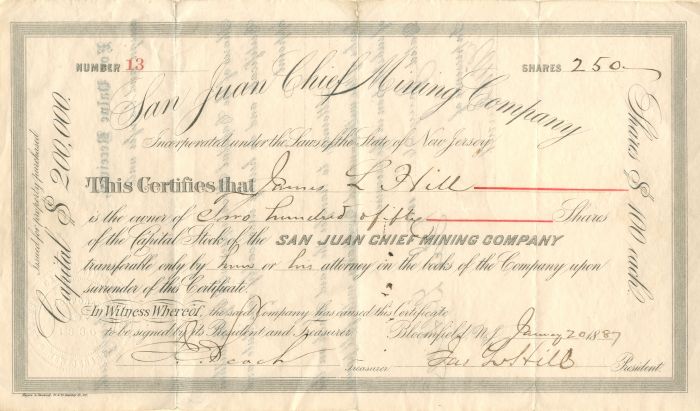San Juan Chief Mining Co. - Stock Certificate - Bloomfield, New Jersey
Inv# MS2296 Stock
Stock printed by Rogers & Sherwood, N.Y. Repair at fold.
Bloomfield is a township in Essex County, New Jersey, United States. As of the 2020 United States Census, the township's population was 53,105. It surrounds the Bloomfield Green Historic District.
The initial patent for the land that would become Bloomfield Township was granted to the English Puritan colonists of Newark, and the area assigned to Essex County in 1675, and Newark Township in 1693. From the 1690s to about the 1720s, much of the northern and eastern land was sold to descendants of New Netherland colonists who had settled Acquackanonk, and the remainder mostly to English families. Speertown (now Upper Montclair), Stone House Plains (now Brookdale), and Second River (now Belleville and Nutley) were essentially Dutch and Jersey Dutch-speaking, while Cranetown, Watsessing, and the Morris Neighborhood (now North Center) were predominantly English. Starting in the mid-18th century, the English and Dutch neighborhoods gradually integrated, with Thomas Cadmus being among the first Dutchmen to settle in an English neighborhood.
Numerous residents served in the Revolutionary War. No significant engagements occurred in Bloomfield, although the locale was on the Continental Army's retreat route after the Battle of Long Island; British and American troops conducted foraging operations; and General George Washington is believed to have visited at least two residences. The Green was set aside to commemorate the use of that space for drilling of militia.
The Presbyterian Society of Bloomfield (now the Bloomfield Presbyterian Church on the Green) was formed in 1794 and named in honor of then-brigadier Joseph Bloomfield, commander of New Jersey troops in the Whiskey Rebellion. About the same time, the Dutch Reformed Church of Stone House Plains (now Brookdale Reformed Church) was established. The two churches became integral institutions of southern and northern Bloomfield, respectively.
Bloomfield was incorporated as a township from portions of Newark Township by an act of the New Jersey Legislature on March 23, 1812. At the time, the Presbyterian parish's namesake was governor of New Jersey and had recently been appointed brigadier general for service in the looming War of 1812.
At the time it was incorporated, the township covered 20.52 square miles (53.1 km2) (almost four times its current area of 5.3 square miles (14 km2)) and included several municipalities which were formed from portions of Bloomfield during the course of the nineteenth century, including Belleville (created on April 8, 1839), Montclair (April 15, 1868), Woodside Township (March 24, 1869) and Glen Ridge (February 13, 1895). The Stone House Plains neighborhood was renamed as Brookdale in 1873.
In the township's first century, Brookdale farms thrived while southern Bloomfield industrialized, and the township's infrastructure, civil framework and social institutions developed. Several miles of the Morris Canal passed through Bloomfield. The Oakes woollen mill thrived as a major supplier to the Union Army.
Bloomfield was incorporated as a town on February 26, 1900. In 1904, The city of Newark failed in its attempts to reannex Bloomfield as part of the "Greater Newark" movement. In 1981, the town was one of seven Essex County municipalities to pass a referendum to become a township, joining four municipalities that had already made the change, of what would ultimately be more than a dozen Essex County municipalities to reclassify themselves as townships in order to take advantage of federal revenue sharing policies that allocated townships a greater share of government aid to municipalities on a per capita basis.
In the 20th century, GE, Westinghouse and Schering built major facilities, and among others, the Charms Candy Company was started and grew. After World War I, Brookdale's farms were developed into residential neighborhoods and supporting services. Substantial population growth continued into the 1950s. During World War II, while many Bloomfield men served in the armed forces, Bloomfield's farms and factories, largely staffed by women, supported the war effort. In the decades after the war, the township's industrial base steadily shut down with stricter environmental regulations, rising labor costs, and growing competition. These influences, as well as construction of the Garden State Parkway, further drove urban decay and related population turnover and stagnation through the latter part of the 20th century.
In the early 21st century, redevelopment of blighted and underutilized properties has further shifted Bloomfield towards being a primarily residential municipality.
A stock certificate is issued by businesses, usually companies. A stock is part of the permanent finance of a business. Normally, they are never repaid, and the investor can recover his/her money only by selling to another investor. Most stocks, or also called shares, earn dividends, at the business's discretion, depending on how well it has traded. A stockholder or shareholder is a part-owner of the business that issued the stock certificates.










Ebay ID: labarre_galleries